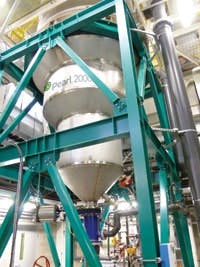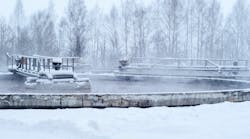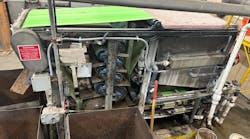Clean Water Services (CWS), a sanitary sewer and surface water management utility located near Portland, Ore., has implemented a new approach to phosphorus management technology with long-time partner, Ostara Nutrient Recovery Technologies of Vancouver, British Columbia, Canada.
Phosphorus Management
In June 2009, the world’s first commercial nutrient recovery facility began operations at Clean Water Services’ Durham Advanced Wastewater Treatment Plant (AWWTP) in Tigard, Ore. Ostara’s nutrient recovery technology at Durham recovered phosphorus from the digested sludge dewatering stream (centrate) to create a sustainable fertilizer product called Crystal Green.
In addition to generating revenue for Clean Water Services by the sale of Crystal Green, operating experience showed the benefits of the technology by reducing the need for chemical addition to augment phosphorus removal and reducing biosolids by more than 10%. These benefits improved both operating reliability and flexibility, and provided substantial cost savings, while helping CWS meet its nutrient limits and protecting the neighboring Tualatin River Watershed. The success of this project opened the door to the nutrient-recovery technology’s installation at CWS’ other large treatment plant, Rock Creek AWWTP.
CWS operates four wastewater treatment facilities serving more than 520,000 people in urban Washington County and small portions of Multnomah County, Clackamas County, Lake Oswego and Portland. Its Durham AWWTP in Tigard treats approximately 25 million gal per day (mgd). The Rock Creek AWWTP in Hillsboro, Ore. treats approximately 35 mgd.
Similar to the Durham AWWTP, Rock Creek AWWTP uses anaerobic digestion, however, the facility is in the early steps of implementing changes to move toward biological phosphorus removal (BioP). Use of Ostara’s nutrient recovery technology provides stability to the nutrient removal process, which will facilitate the transition to BioP. Since completing the Durham plant, Ostara developed a design for its nutrient recovery process (Pearl), promising four times the treatment capacity with virtually the same cost and footprint.
CWS and Ostara agreed to collaborate on the first implementation of this new design at the Rock Creek facility. Two of Ostara’s Pearl 2000 reactors were installed in a new building at the Rock Creek AWWTP, which, combined, are capable of producing 4 tons of fertilizer per day by removing more than 1,000 lb of phosphorus. Construction of the new Pearl plant was completed and commissioned in early 2012 and now is fully operational.
The fertilizer that CWS is producing at the Rock Creek and Durham facilities is marketed as a valable fertilizer made from the only renewable source of phosphorus: wastewater. It is a highly pure, slow-release phosphorus, magnesium and nitrogen fertilizer, intended to replace multiple applications of conventional forms of phosphorus, thus, lowering labor and input costs.
The Collaboration Continues
CWS was interested in maximizing the production of fertilizer by sending as much phosphorus as possible to the facility. This led to the development of its Waste Activated Sludge Stripping to Remove Internal Phosphorous (WASSTRIP) process, which takes waste-activated sludge and holds it under anaerobic conditions, causing the phosphorus accu- mulating organisms (PAOs) to release phosphorus and magnesium. The WASSTRIP process mirrors the release of phosphorus by PAOs that occur in the anaerobic zone of all BioP plants.
After the WASSTRIP process, the waste-activated sludge is thickened prior to digestion. The thickening centrate stream contains the released phosphorous and magnesium, which is sent directly to the nutrient recovery facility. The thickened sludge sent to the digester therefore contains significantly less phosphorous and magnesium, which are two key limiting inputs for struvite formation in the digester. This is a benefit because struvite formed in the digester represents a lost potential revenue.
At Durham, the waste-activated sludge is held for approximately 13 hours in a pre-existing sludge storage tank. The rate of phosphorous and magnesium release is accelerated by the addition of a small amount of primary sludge fermentate to the process.
Approximately half of the total phosphorous content of the waste-activated sludge is dissolved by the WASSTRIP process, doubling the amount of phosphorus sent for nutrient recovery. This doubles the mass of phosphorous that is transformed into Crystal Green fertilizer.
In April 2011, the Durham AWWTP implemented the WASSTRIP process. Since then, the removal of phosphorous and magnesium prior to the digester has prevented struvite formation in the digester, delivering a number of benefits, including:
Improved digester performance resulting in reduced biosolids volumes and increased gas production: The WASSTRIP process has reduced biosolids quantities by an additional 10% (on top of the 10% already achieved when just treating dewatering centrate), reducing biosolids disposal costs. Struvite scale prevention throughout the sludge treatment stream, reducing operation and maintenance costs and the need for capital replacements. Struvite formation in the digester has been decreased by more than 90% CWS has entered into an exclusive partnership agreement with Ostara to sell WASSTRIP technology and, in turn, Ostara currently is constructing the second full-scale WASSTRIP process for the city of Saskatoon, Saskatchewan, Canada.
The Bottom Line
Nutrient recovery closes the loop on finite natural resources such as phosphorus. Wastewater treatment facilities that install this system contribute to environmental sustainability from dual perspectives:
• They emit fewer pollutants into the environment by the recovery of phosphorus and displace commercial phosphorus-based fertilizers that can pollute the environment.
• They generate a new, renewable and non-polluting form of phosphorus that is essential to the world’s food supply.
Download: Here


